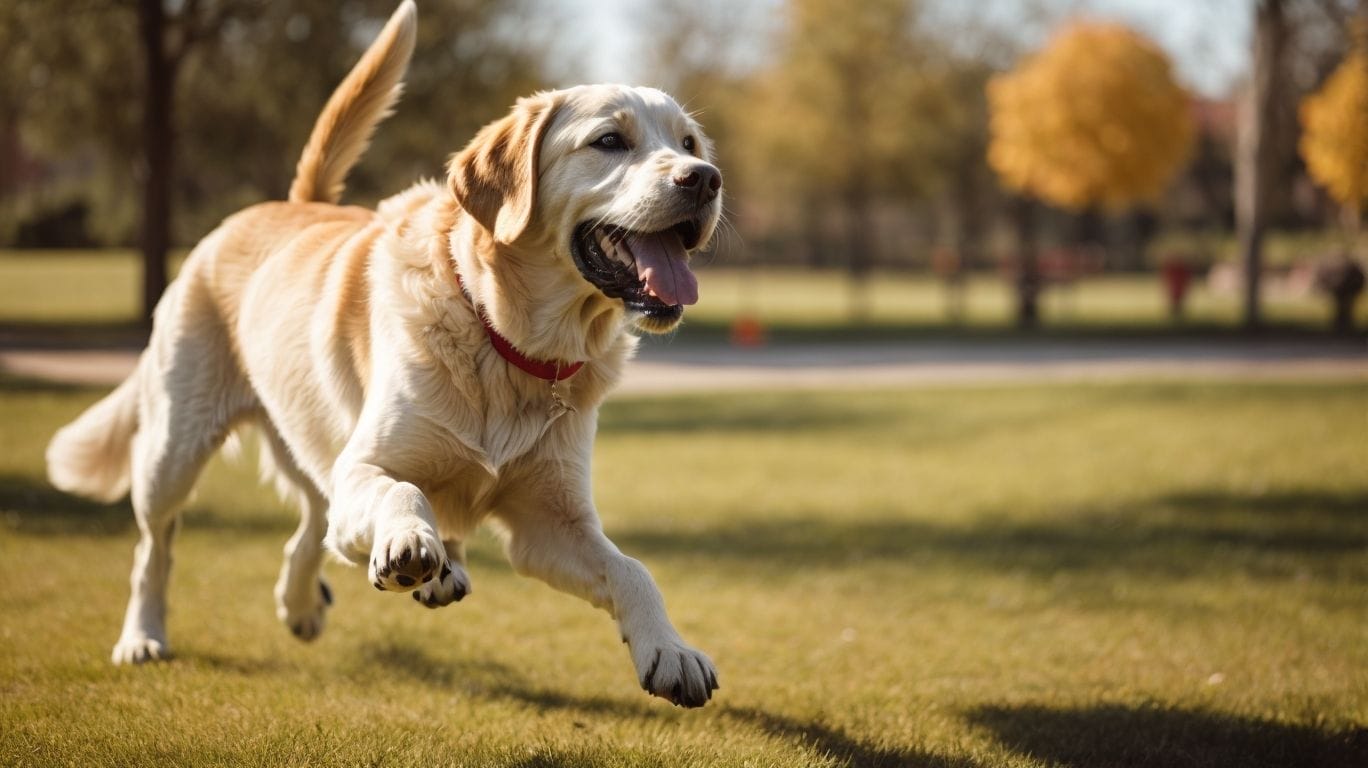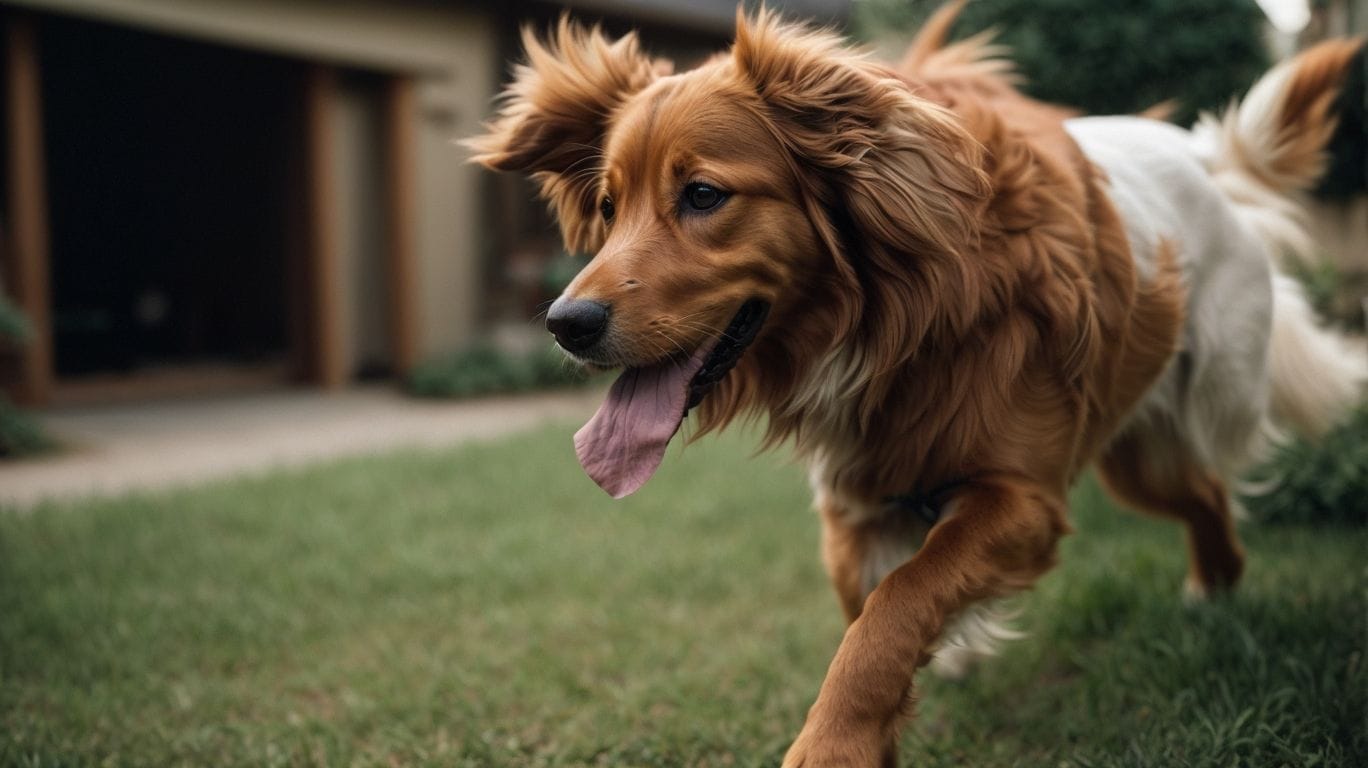Dogs have a unique way of expressing themselves, and one of the most recognizable forms of communication is through their tail wagging. It is a fascinating behavior that sparks curiosity in many dog owners and enthusiasts. Understanding why dogs wag their tails is key to interpreting their emotions and intentions. The anatomy and function of a dog’s tail play a crucial role in their communication system. The purpose of a dog’s tail and how it works are fundamental questions to explore. Decoding the meaning behind a wagging tail and interpreting canine body language can provide valuable insights into a dog’s emotions. Tail wagging is just one aspect of a dog’s communication repertoire, and exploring other forms of communication, such as vocalizations, body posture, and facial expressions, can provide a comprehensive understanding of a dog’s thoughts and feelings. By delving into the different types of tail wagging, including friendly, fearful, and aggressive wags, we can gain a deeper insight into the complex language of our beloved canine companions.
Key takeaways:
- Dogs wag their tails to communicate: Tail wagging is a form of expression for dogs, allowing them to convey various emotions and messages to humans and other animals.
- Understanding tail-wagging body language: The speed, direction, and position of a dog’s tail can provide valuable insights into their mood, intentions, and level of comfort or discomfort.
- Different types of tail wagging: A wagging tail can indicate friendliness, fear,xiety, or aggression. It is important to consider other forms of communication, such as vocalizations, body posture, and facial expressions, to interpret a dog’s overall state accurately.
The Anatomy and Function of a Dog’s Tail

Photo Credits: Petnarnia.Com by Eugene Nguyen
The anatomy and function of a dog’s tail are essential for communication and balance. The tail is composed of vertebrae, muscles, and nerves that enable dogs to move it in various ways. Dogs utilize their tails to express emotions and interact with other animals and humans. A wagging tail can signify happiness or excitement, while a tucked tail may indicate fear or submission. Additionally, dogs rely on their tails to maintain balance while running or traversing different terrains. Acquiring an understanding of a dog’s tail can provide valuable insights into their behavior and emotions.
What is the Purpose of a Dog’s Tail?
The purpose of a dog’s tail is multifaceted and serves various functions. It aids in communication, allowing dogs to express their emotions and intentions. It helps with balance and coordination during movements and changes in direction. Dogs also use their tails for social interactions, such as signaling friendliness or aggression. Understanding the purpose of a dog’s tail is crucial for interpreting their behavior accurately. When interacting with dogs, please pay attention to their tail position, movement, and speed for insight into their mood and intentions. Remember that each dog’s tail wagging may vary, so consider their overall body language for a complete understanding.
How Does a Dog’s Tail Work?
How Does a Dog’s Tail Work?
A dog’s tail is a complex structure composed of bones and muscles that enable various movements and serve multiple purposes. The tail consists of vertebrae connected by ligaments and tendons, allowing for flexibility and control. Muscles attached to the tail provide the power needed for wagging and other movements. Nerves in the tail provide sensory information, allowing dogs to sense their surroundings and communicate. The tail acts as an expressive tool, conveying emotions like happiness, fear, or aggressiveness. It also helps with balance and coordination while running or jumping. A dog’s tail is a remarkable appendage that plays a crucial role in their communication and physical abilities.
The origin of the dogs’ tails can be traced back to their wolf ancestors. Wolves used their tails for communication within the pack and as a means of expressing dominance or submission. Over time, as dogs evolved from wolves and were domesticated, their tails adapted to serve different functions based on their breed and purpose. Today, the structure and function of a dog’s tail continue to be an important aspect of their overall behavior and communication with humans and other animals.
Understanding Dog Tail Wagging

Photo Credits: Petnarnia.Com by Alexander Johnson
Understanding dog tail wagging is essential for pet owners. It is crucial to comprehend that tail wagging is a means of communication that reflects a dog’s emotions. Here are a few critical factors to keep in mind when attempting to interpret tail wagging:
- Speed: A slow wag can indicate uncertainty or caution, while a fast wag often signifies excitement or happiness.
- Direction: A wag to the right suggests positive emotions, while a wag to the left can signal anxiety or fear.
- Body language: Observing other body cues, such as relaxed muscles or a wagging body, can aid in interpreting the meaning behind the wagging.
- Context: To fully understand the message being conveyed, the situation and the dog’s overall behavior and interactions should also be considered.
What Does a Wagging Tail Mean?
What Does a Wagging Tail Mean?
A wagging tail in dogs can communicate various emotions and intentions. Understanding the meaning behind the wag is essential to interpreting our furry friends accurately. Different types of tail wagging indicate different states of mind:
| Type of Wag | Meaning |
|---|---|
| Friendly wags: | If a dog’s tail is loose and wide, it suggests happiness, friendliness, and a desire for interaction. |
| Fearful or anxious wags: | On the other hand, a low and stiff wag may indicate fear or unease. |
| Aggressive or defensive wags: | If the tail is high and rigid, often accompanied by raised fur, it can signal aggression or act as a warning. |
While hiking, I came across a stray dog. Its slow, low tail wag indicated fear, prompting me to give it space and avoid triggering any aggression. Why Do Dogs Wag Their Tails?
Canine Body Language: Interpreting Tail Wagging
Interpreting tail wagging is an important aspect of understanding canine body language. Canine body language involves interpreting a dog’s tail wagging, as it can reveal valuable information about a dog’s emotions. The position, speed, and duration of the wag are key factors in deciphering a dog’s feelings. A high, fast wag usually indicates happiness and friendliness, while a low, slower wag can signify nervousness or anxiety. Additionally, a tail held stiffly or tucked between the legs suggests fear or aggression. However, it’s crucial to consider other signs of body language and the context to interpret a dog’s tail wagging accurately. Relying solely on tail wagging is not enough to determine a dog’s mood.
Fun Fact: Dogs wag their tails not only to communicate with humans but also to communicate with other dogs.
Emotions and Communication

Photo Credits: Petnarnia.Com by Gregory Ramirez
Dogs naturally communicate their emotions to humans and other animals by wagging their tails. For effective communication, it is crucial to understand the underlying meaning behind their tail wagging. Here are some vital factors to take into account:
Tail position: Dogs holding their tails high usually indicate excitement or confidence, whereas a low tail position might signal fear or submission.
Speed of wagging: A fast wagging tail often signifies excitement, while a slow wagging tail can indicate uncertainty or apprehension.
Direction of wagging: Generally, a wag to the right conveys positive emotions, whereas a wag to the left can suggest negative or anxious feelings.
Accompanying body language: It is important to observe other aspects, such as ear position and body posture, as they can provide additional insight into a dog’s emotions.
Always remember to consider the overall context when interpreting a dog’s wagging tail. If unsure, seeking guidance from a professional dog behaviorist can be helpful in understanding emotions and communication.
How Dogs Use Tail Wagging to Communicate
How Dogs Use Tail Wagging to Communicate
Dogs use tail wagging as a form of communication to convey various messages to other animals and humans. It is a natural way for them to express their emotions and intentions. For example, understanding how dogs use tail wagging to communicate can help us interpret their emotional state. A fast and wide tail wag typically indicates friendliness and excitement, while a slow and low tail wag may signal fear or anxiety. It’s important to consider the context and other body language cues when interpreting tail wagging. By understanding how dogs use tail wagging to communicate, we can better comprehend a dog’s emotional state and respond accordingly.
What Causes a Dog’s Tail to Wag Faster or Slower?
What Causes a Dog’s Tail to Wag Faster or Slower?
When a dog’s tail wags faster or slower, it is a reflection of their emotional state and can provide insight into how they are feeling. Several factors can influence the speed of tail wagging, including the dog’s excitement level and overall mood. Positive emotions like happiness or excitement often lead to a faster wag, while fear or anxiety can result in a slower wag. The direction and height of the tail can also convey different messages. Understanding these subtleties can help us better interpret and respond to our furry friends. Remember to pay attention to the overall body language and vocalizations to gain a comprehensive understanding of a dog’s emotions.
To determine patterns, observe your dog’s tail wagging speed in different situations. Providing a calm and positive environment can promote faster and more enthusiastic tail-wagging. If you notice any concerning changes in your dog’s tail-wagging behavior, it is advisable to consult a professional dog behaviorist.
The Different Types of Tail Wagging

Photo Credits: Petnarnia.Com by Kyle Harris
When it comes to dogs wagging their tails, there’s more than meets the eye! In this part, we’ll dive into the fascinating world of tail wagging and explore its different types, from friendly wags that show pure joy and excitement to fearful or anxious wags that reveal their nervousness and even aggressive or defensive wags that signal a potential threat. Get ready to decode the language of tails and gain a deeper understanding of our canine companions.
1. Friendly Wags
A dog wagging its tail can indicate friendliness and happiness. Here are some characteristics to look for when identifying friendly tail wags:
- A relaxed and loose wag: A friendly wag is typically loose and fluid, with the tail moving from side to side in a relaxed manner.
- A wide wag: The wag may cause the entire tail to move, including the base.
- A high wag: A dog’s tail wagging high above the spine can indicate excitement and friendliness.
- A slow wag: A slower wag can show social interest and a desire to engage.
2. Fearful or Anxious Wags
Fearful or anxious tail wags in dogs can be a clear indication of their emotional states. It is crucial to accurately identify and understand these wags when it comes to your furry friend. Here are some essential points regarding fearful or anxious wags:
- Tail position: If a dog tucks its tail and holds it low between the legs, it can be a sign of fear or anxiety.
- Slow and stiff wag: A wag that is slow, stiff, and lacks movement may indicate nervousness or unease.
- Quick wags: Rapid and short wags can be a signal of fear and potential aggression.
- Context: It is important to observe the overall body language of the dog in order to interpret the meaning behind a fearful or anxious tail wag.
Fact: Dogs displaying fearful or anxious tail wags may greatly benefit from positive reinforcement training and a calm, supportive environment.
3. Aggressive or Defensive Wags
Aggressive or defensive tail wags in dogs can indicate a warning or potential danger. Understanding these types of tail wagging is crucial to interpreting a dog’s behavior.
- Stiff and high tail position: This indicates a heightened state of aggression or defensiveness.
- Rapid wagging with a stiff body: It signifies an aggressive stance and potential aggression.
- Slow and low wagging with a tucked tail: This suggests fear, submission, or a defensive response.
- Raised hackles, along with a tense tail: It signifies extreme aggression and potential aggression.
By observing a dog’s tail posture and wagging speed, you can better assess their emotional state and respond appropriately to ensure safety.
Other Forms of Communication

Photo Credits: Petnarnia.Com by Benjamin Davis
They are discovering the intriguing world of canine communication beyond tail wagging! Unveiling other captivating forms of expression that our furry friends employ. From vocalizations to subtle body postures and the secret language of their adorable facial expressions. Unearth the captivating insights into how dogs convey their thoughts, intentions, and emotions. Please find out how these subtle cues enhance our understanding and strengthen the bond between humans and their beloved canine companions.
1. Vocalizations
Vocalizations play a vital role in a dog’s communication repertoire. Dogs naturally use a range of vocal sounds, such as barking, growling, whimpering, howling, and whining, to express their emotions, needs, and desires. Among these, barking is the most prevalent vocalization, which can have multiple meanings depending on the situation. It can serve as an alert, display playfulness, signify fear, aggression, or even frustration. Growling serves as a warning sign, indicating that a dog feels threatened or defensive.
On the other hand, whimpering and whining are typically associated with discomfort, pain, or seeking attention. To effectively communicate with dogs and foster a strong bond, it is crucial to grasp and interpret their vocalizations. Additionally, paying attention to other body language cues is essential for accurately comprehending a dog’s vocalizations. It is important to remember that each dog is distinct, and vocalization can differ based on breed, personality, and individual preferences.
2. Body Posture
A dog’s body posture is a crucial aspect of their communication. Understanding the way a dog positions its body can provide insights into their emotions and intentions. Here are some essential points to know about dog body posture:
- Posture signals: Dogs may exhibit various postures, including a relaxed and balanced stance, a stiff and tense body, or a lowered and submissive posture.
- Confidence and dominance: A dog with an upright posture and raised head typically indicates confidence and dominance. Conversely, a dog with a lowered posture may display submission.
- Aggression: Aggressive body postures consist of a stiff and rigid body, direct eye contact, and raised hackles. These signs suggest that the dog may be ready to attack.
- Fear and anxiety: Dogs that experience fear or anxiety might show a hunched posture, lowered tail, and ears pulled back.
- Communication with humans: Understanding a dog’s body posture can assist us in better interpreting their emotions and responding accordingly.
Paying attention to a dog’s body posture can provide valuable information about their state of mind and aid us in establishing effective communication with them.
3. Facial Expressions
Dog’s facial expressions can communicate a lot about their emotions and intentions.
- Happy face: When a dog has relaxed, open eyes, a relaxed mouth, and naturally held ears, it typically indicates contentment and relaxation.
- Fearful face: if a dog shows wide eyes, raised brows, and a tense mouth, it may be experiencing fear or anxiety.
- Aggressive face: An aggressive dog often reveals intense staring, raised fur around the face and neck, and a wrinkled snout.
- Submissive face: A submissive dog may avert their gaze, lower their head, and have a closed or slightly open mouth.
- Playful face: When a dog is in a playful mood, it may exhibit a wide-mouthed grin, relaxed eyes, and a wagging tail.
Some Facts About Why Do Dogs Wag Their Tails:
- ✅ Dogs wag their tails to communicate their emotions and reactions (Source: petMD)
- ✅ The position and speed of the tail wag can indicate the dog’s mood (Source: petMD)
- ✅ Different tail movements convey different emotions (Source: AKC)
- ✅ The direction in which a dog wags its tail can also indicate its mood (Source: AKC)
- ✅ Reading a dog’s tail and body language is the best way to understand their feelings (Source: AKC)


